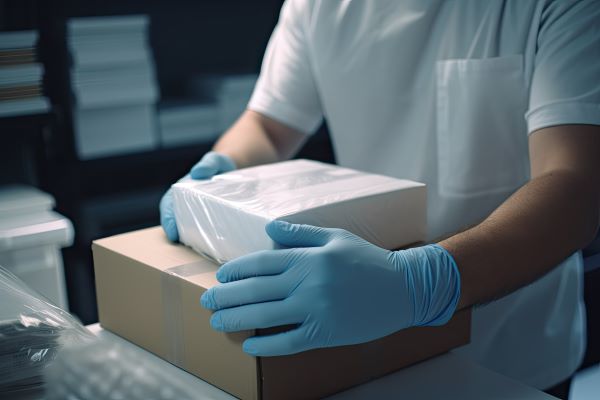From time to time, we help organise and relocation commercial premises. In this post about laboratory relocation, the key takeaways are:
- Thorough Planning is Essential: Effective laboratory relocation requires detailed planning, risk assessments, and coordination between locations for safe, efficient management.
- Specialized Handling and Compliance are Crucial: Hiring experienced movers and adhering to regulatory compliance are key for the safe transport of sensitive materials.
- Systematic Packing and Labeling: Proper packing and clear labeling ensure the protection of equipment and smooth transition to the new facility.
Relocating a laboratory is a critical process that requires meticulous planning and precise execution. It involves more than just moving physical items from one location to another; it’s about ensuring the continuity of sensitive and often vital research activities, maintaining the integrity of complex scientific instruments, and safeguarding valuable data and materials.
This guide aims to provide practical tips to facilitate a smooth and safe transition. By emphasizing thorough planning, risk management, and adherence to safety protocols, laboratory managers and their teams can navigate the complexities of the relocation process.
-
Hire Experienced Movers
Choosing the right moving company is pivotal in ensuring the safe transport of sensitive laboratory equipment and hazardous materials. Opt for laboratory relocation services with a proven track record in lab relocations, as they possess the necessary expertise and specialized equipment to handle delicate instruments and comply with regulatory standards for hazardous materials. Verify their credentials and seek references to confirm their ability to manage the complexities of a laboratory move safely.
-
Plan Thoroughly
Successful laboratory relocation begins with meticulous planning. Start by creating a detailed relocation plan that encompasses timelines for each phase of the move, specific responsibilities assigned to team members, and a comprehensive inventory list that categorizes all laboratory items.
It’s crucial to conduct thorough risk assessments to identify potential safety risks and logistical challenges associated with moving various types of equipment and materials. These assessments will guide the development of mitigation strategies, ensuring that every aspect of the move is conducted under controlled and safe conditions.
-
Label Everything Clearly
Accurate labelling is essential in a laboratory relocation. Each container, box, and piece of equipment should be clearly marked with detailed descriptions of its contents, specific handling instructions, and the designated area in the new location.
This not only aids in the orderly transfer of materials but also minimizes the risk of mishandling or misplacement. For hazardous materials, labels should reflect the latest regulatory compliance standards to ensure they are handled safely throughout the move.
Proper packing is critical to protect fragile laboratory equipment and maintain the viability of biological samples during transport. Utilize high-quality, shock-absorbent materials to cushion and stabilize items and employ static-free packaging for electronic components.
Furthermore, you should transport temperature-sensitive materials in insulated containers to maintain a stable environment and prevent degradation. It would be best if you also took special care to ensure that all packing materials meet the specific needs of each item.
-
Coordinate With Both Locations
Ensure seamless coordination between the current and future laboratory facilities. This includes setting up necessary utilities such as electricity, gas, and water and establishing appropriate storage and security measures at the new site before the move begins. Effective communication among all parties involved, including facility managers, lab technicians, and security personnel, is crucial to synchronize the move and prepare both sites for a smooth transition.
-
Ensure Regulatory Compliance
Navigating the complex web of regulatory requirements is essential during a laboratory relocation. Before moving, thoroughly review all applicable laws and regulations related to the transport of hazardous materials, biological specimens, and sensitive lab equipment across jurisdictions.
This includes securing all necessary permits and ensuring that packaging and transportation methods meet all legal standards. Compliance with these regulations not only ensures the legal transportation of materials but also protects the safety of everyone involved and the environment. Regular consultations with legal experts or regulatory bodies can provide guidance and help prevent potential legal issues.
-
Transportation Logistics
The logistics of moving laboratory materials should be planned with precision. Select the safest and most efficient transportation routes, considering potential hazards such as poor road conditions, traffic, and environmental factors. In cases where hazardous or exceptionally delicate materials are involved, consider arranging for security escorts or obtaining special transportation permits to enhance safety during transit.
-
Safety Training
All personnel involved in the laboratory move must receive training tailored to the specific requirements of the relocation. This training should cover general safety protocols, emergency procedures, and the correct methods for handling the laboratory’s unique materials and equipment. Empowering every team member with this knowledge is fundamental to preventing accidents and ensuring a safe move.
-
Document Everything
Documentation plays a critical role in any professional laboratory relocation. Maintain thorough records of all items being moved, including detailed descriptions and condition reports both before and after the move. These records are essential for insurance purposes and can be invaluable in resolving any disputes that arise regarding the condition of the relocated items.
-
Gradual Setup
Once the move is complete, prioritize the setup and calibration of critical lab equipment to minimize operational downtime. It is advisable to systematically test each piece of equipment after installation to confirm its functionality. This phased approach to setting up the new laboratory helps identify any issues that may have arisen during the move, allowing for timely resolutions that facilitate a smooth resumption of research activities.
-
Review And Learn
After the relocation, conduct a thorough review of the entire process. This review should assess what aspects of the move went well and identify areas for improvement. Gathering feedback from key participants can provide insights into potential enhancements for future relocations. Continuous improvement of the relocation process will contribute to more efficient and safer laboratory moves in the future.
Conclusion
With thorough preparation and careful execution, laboratories can successfully navigate the challenges of relocation, minimizing downtime and maintaining the integrity of valuable research and resources. This strategic approach not only facilitates a seamless move but also sets the stage for future operational success in the new facility.


